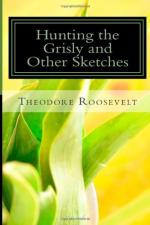In 1862 Mr. Clarence King, while riding along the overland trail through western Kansas, passed through a great buffalo herd, and was himself injured in an encounter with a bull. The great herd was then passing north, and Mr. King reckoned that it must have covered an area nearly seventy miles by thirty in extent; the figures representing his rough guess, made after travelling through the herd crosswise, and upon knowing how long it took to pass a given point going northward. This great herd of course was not a solid mass of buffaloes; it consisted of innumerable bands of every size, dotting the prairie within the limits given. Mr. King was mounted on a somewhat unmanageable horse. On one occasion in following a band he wounded a large bull, and became so wedged in by the maddened animals that he was unable to avoid the charge of the bull, which was at its last gasp. Coming straight toward him it leaped into the air and struck the afterpart of the saddle full with its massive forehead. The horse was hurled to the ground with a broken back, and King’s leg was likewise broken, while the bull turned a complete somerset over them and never rose again.
In the recesses of the Rocky Mountains, from Colorado northward through Alberta, and in the depths of the subarctic forest beyond the Saskatchewan, there have always been found small numbers of the bison, locally called the mountain buffalo and wood buffalo; often indeed the old hunters term these animals “bison,” although they never speak of the plains animals save as buffalo. They form a slight variety of what was formerly the ordinary plains bison, intergrading with it; on the whole they are darker in color, with longer, thicker hair, and in consequence with the appearance of being heavier-bodied and shorter-legged. They have been sometimes spoken of as forming a separate species; but, judging from my own limited experience, and from a comparison of the many hides I have seen, I think they are really the same animal, many individuals of the two so-called varieties being quite indistinguishable. In fact, the only moderate-sized herd of wild bison in existence to-day, the protected herd in the Yellowstone Park, is composed of animals intermediate in habits and coat between the mountain and plains varieties—as were all the herds of the Bighorn, Big Hole, Upper Madison, and Upper Yellowstone valleys.
However, the habitat of these wood and mountain bison yielded them shelter from hunters in a way that the plains never could, and hence they have always been harder to kill in the one place than in the other; for precisely the same reasons that have held good with the elk, which have been completely exterminated from the plains, while still abundant in many of the forest fastnesses of the Rockies. Moreover, the bison’s dull eyesight is no special harm in the woods, while it is peculiarly hurtful to the safety of any beast on the plains, where eyesight avails more than any other sense, the true game of the plains being the prong-buck, the most keen-sighted of American animals. On the other hand the bison’s hearing, of little avail on the plains, is of much assistance in the woods; and its excellent nose helps equally in both places.




